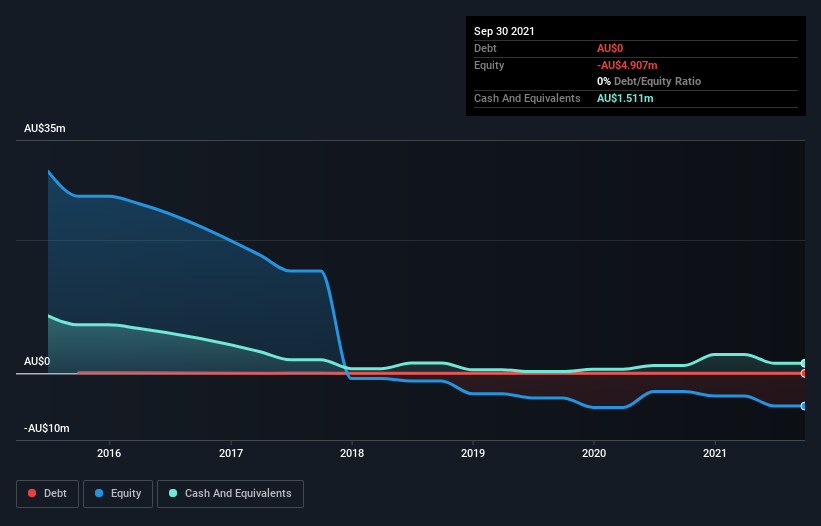Will Flexiroam (ASX:FRX) Spend Its Cash Wisely?

Just because a business does not make any money, does not mean that the stock will go down. For example, biotech and mining exploration companies often lose money for years before finding success with a new treatment or mineral discovery. Having said that, unprofitable companies are risky because they could potentially burn through all their cash and become distressed.
Given this risk, we thought we'd take a look at whether Flexiroam (ASX:FRX) shareholders should be worried about its cash burn. For the purpose of this article, we'll define cash burn as the amount of cash the company is spending each year to fund its growth (also called its negative free cash flow). First, we'll determine its cash runway by comparing its cash burn with its cash reserves.
See our latest analysis for Flexiroam
How Long Is Flexiroam's Cash Runway?
A company's cash runway is the amount of time it would take to burn through its cash reserves at its current cash burn rate. In September 2021, Flexiroam had AU$1.5m in cash, and was debt-free. Looking at the last year, the company burnt through AU$1.3m. That means it had a cash runway of around 14 months as of September 2021. That's not too bad, but it's fair to say the end of the cash runway is in sight, unless cash burn reduces drastically. You can see how its cash balance has changed over time in the image below.

How Well Is Flexiroam Growing?
Some investors might find it troubling that Flexiroam is actually increasing its cash burn, which is up 12% in the last year. Also concerning, operating revenue was actually down by 38% in that time. Taken together, we think these growth metrics are a little worrying. In reality, this article only makes a short study of the company's growth data. This graph of historic earnings and revenue shows how Flexiroam is building its business over time.
Can Flexiroam Raise More Cash Easily?
Flexiroam revenue is declining and its cash burn is increasing, so many may be considering its need to raise more cash in the future. Generally speaking, a listed business can raise new cash through issuing shares or taking on debt. One of the main advantages held by publicly listed companies is that they can sell shares to investors to raise cash and fund growth. By looking at a company's cash burn relative to its market capitalisation, we gain insight on how much shareholders would be diluted if the company needed to raise enough cash to cover another year's cash burn.
Since it has a market capitalisation of AU$28m, Flexiroam's AU$1.3m in cash burn equates to about 4.7% of its market value. Given that is a rather small percentage, it would probably be really easy for the company to fund another year's growth by issuing some new shares to investors, or even by taking out a loan.
So, Should We Worry About Flexiroam's Cash Burn?
On this analysis of Flexiroam's cash burn, we think its cash burn relative to its market cap was reassuring, while its falling revenue has us a bit worried. Even though we don't think it has a problem with its cash burn, the analysis we've done in this article does suggest that shareholders should give some careful thought to the potential cost of raising more money in the future. Separately, we looked at different risks affecting the company and spotted 5 warning signs for Flexiroam (of which 1 shouldn't be ignored!) you should know about.
Of course Flexiroam may not be the best stock to buy. So you may wish to see this free collection of companies boasting high return on equity, or this list of stocks that insiders are buying.
New: AI Stock Screener & Alerts
Our new AI Stock Screener scans the market every day to uncover opportunities.
• Dividend Powerhouses (3%+ Yield)
• Undervalued Small Caps with Insider Buying
• High growth Tech and AI Companies
Or build your own from over 50 metrics.
This article by Simply Wall St is general in nature. We provide commentary based on historical data and analyst forecasts only using an unbiased methodology and our articles are not intended to be financial advice. It does not constitute a recommendation to buy or sell any stock, and does not take account of your objectives, or your financial situation. We aim to bring you long-term focused analysis driven by fundamental data. Note that our analysis may not factor in the latest price-sensitive company announcements or qualitative material. Simply Wall St has no position in any stocks mentioned.
Have feedback on this article? Concerned about the content? Get in touch with us directly. Alternatively, email editorial-team (at) simplywallst.com.
About ASX:FRX
Flexiroam
Engages in the telecommunications and Internet of Things (IoT) connectivity business worldwide.
Good value slight.
Market Insights
Community Narratives


